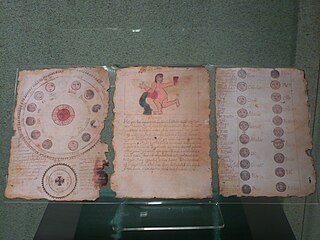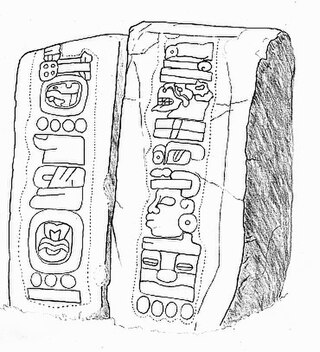
The traditional Chinese calendar, dating back to the Han dynasty, is a lunisolar calendar that blends solar, lunar, and other cycles for social and agricultural purposes. While modern China primarily uses the Gregorian calendar for official purposes, the traditional calendar remains culturally significant. It determines the timing of Chinese New Year with traditions like the twelve animals of the Chinese Zodiac still widely observed.
Intercalation or embolism in timekeeping is the insertion of a leap day, week, or month into some calendar years to make the calendar follow the seasons or moon phases. Lunisolar calendars may require intercalations of days or months.
The Maya calendar is a system of calendars used in pre-Columbian Mesoamerica and in many modern communities in the Guatemalan highlands, Veracruz, Oaxaca and Chiapas, Mexico.

The Mayan languages form a language family spoken in Mesoamerica, both in the south of Mexico and northern Central America. Mayan languages are spoken by at least six million Maya people, primarily in Guatemala, Mexico, Belize, El Salvador and Honduras. In 1996, Guatemala formally recognized 21 Mayan languages by name, and Mexico recognizes eight within its territory.
The tzolkʼin is the 260-day Mesoamerican calendar used by the Maya civilization of pre-Columbian Mesoamerica.

The Books of Chilam Balam are handwritten, chiefly 17th and 18th-centuries Maya miscellanies, named after the small Yucatec towns where they were originally kept, and preserving important traditional knowledge in which indigenous Maya and early Spanish traditions have coalesced. They compile knowledge on history, prophecy, religion, ritual, literature, the calendar, astronomy, and medicine. Written in the Yucatec Maya language and using the Latin alphabet, the manuscripts are attributed to a legendary author called Chilam Balam, a chilam being a priest who gives prophecies and balam a common surname meaning ʼjaguarʼ. Some of the texts actually contain prophecies about the coming of the Spaniards to Yucatán while mentioning a chilam Balam as their first author.

Classic Maya is the oldest historically attested member of the Mayan language family. It is the main language documented in the pre-Columbian inscriptions of the classical period of the Maya civilization. It is also the common ancestor of the Cholan branch of the Mayan language family. Contemporary descendants of classical Maya include Chʼol and Chʼortiʼ. Speakers of these languages can understand many Classic Mayan words.

The calendrical systems devised and used by the pre-Columbian cultures of Mesoamerica, primarily a 260-day year, were used in religious observances and social rituals, such as divination.

Maya script, also known as Maya glyphs, is historically the native writing system of the Maya civilization of Mesoamerica and is the only Mesoamerican writing system that has been substantially deciphered. The earliest inscriptions found which are identifiably Maya date to the 3rd century BCE in San Bartolo, Guatemala. Maya writing was in continuous use throughout Mesoamerica until the Spanish conquest of the Maya in the 16th and 17th centuries. Though modern Mayan languages are almost entirely written using the Latin alphabet rather than Maya script, there have been recent developments encouraging a revival of the Maya glyph system.

The Dresden Codex is a Maya book, which was believed to be the oldest surviving book written in the Americas, dating to the 11th or 12th century. However, in September 2018 it was proven that the Maya Codex of Mexico, previously known as the Grolier Codex, is, in fact, older by about a century. The codex was rediscovered in the city of Dresden, Germany, hence the book's present name. It is located in the museum of the Saxon State Library. The codex contains information relating to astronomical and astrological tables, religious references, seasons of the earth, and illness and medicine. It also includes information about conjunctions of planets and moons.

Ajaw or Ahau ('Lord') is a pre-Columbian Maya political title attested from epigraphic inscriptions. It is also the name of the 20th day of the tzolkʼin, the Maya divinatory calendar, on which a ruler's kʼatun-ending rituals would fall.
A veintena is the Spanish-derived name for a 20-day period used in pre-Columbian Mesoamerican calendars. The division is often casually referred to as a "month", although it is not coordinated with the lunar cycle. The term is most frequently used with respect to the 365-day Aztec calendar, the xiuhpohualli, although 20-day periods are also used in the 365-day Maya calendar, as well as by other Mesoamerican civilizations such as the Zapotec and Mixtec.
The xiuhpōhualli is a 365-day calendar used by the Aztecs and other pre-Columbian Nahua peoples in central Mexico. It is composed of eighteen 20-day "months," which through Spanish usage came to be known as veintenas, with an inauspicious, separate 5-day period at the end of the year called the nēmontēmi. The name given to the 20-day periods in pre-Columbian times is unknown, and though the Nahuatl word for moon or month, mētztli, is sometimes used today to describe them, the sixteenth-century missionary and ethnographer, Diego Durán explained that:
In ancient times the year was composed of eighteen months, and thus it was observed by these Indian people. Since their months were made of no more than twenty days, these were all the days contained in a month, because they were not guided by the moon but by the days; therefore, the year had eighteen months. The days of the year were counted twenty by twenty.

The Mesoamerican Long Count calendar is a non-repeating base-20 and base-18 calendar used by pre-Columbian Mesoamerican cultures, most notably the Maya. For this reason, it is often known as the MayaLong Count calendar. Using a modified vigesimal tally, the Long Count calendar identifies a day by counting the number of days passed since a mythical creation date that corresponds to August 11, 3114 BCE in the proleptic Gregorian calendar. The Long Count calendar was widely used on monuments.

Chʼoltiʼ is a dead language belonging to the Ch’olan branch of the Mayan family of languages. It was spoken in Belize and Guatemala prior to its extinction in the late eighteenth century. It and its sister Chʼortiʼ language are now deemed likely descendants of Classic Mayan, the language represented in Mayan hieroglyphic writing.

The Dreamspell is an esoteric calendar in part inspired by the Maya calendar by New Age spiritualist, Mayanist philosopher, and author José Argüelles and Lloydine Burris Argüelles. The Dreamspell calendar was initiated in 1987 and released as a board game in 1990.

The Maya civilization was a Mesoamerican civilization that existed from antiquity to the early modern period. It is known by its ancient temples and glyphs (script). The Maya script is the most sophisticated and highly developed writing system in the pre-Columbian Americas. The civilization is also noted for its art, architecture, mathematics, calendar, and astronomical system.

The 2012 phenomenon was a range of eschatological beliefs that cataclysmic or transformative events would occur on or around 21 December 2012. This date was regarded as the end-date of a 5,126-year-long cycle in the Mesoamerican Long Count calendar, and festivities took place on 21 December 2012 to commemorate the event in the countries that were part of the Maya civilization, with main events at Chichén Itzá in Mexico and Tikal in Guatemala.
Maya astronomy is the study of the Moon, planets, Milky Way, Sun, and astronomical phenomena by the Precolumbian Maya civilization of Mesoamerica. The Classic Maya in particular developed some of the most accurate pre-telescope astronomy in the world, aided by their fully developed writing system and their positional numeral system, both of which are fully indigenous to Mesoamerica. The Classic Maya understood many astronomical phenomena: for example, their estimate of the length of the synodic month was more accurate than Ptolemy's, and their calculation of the length of the tropical solar year was more accurate than that of the Spanish when the latter first arrived. Many temples from the Maya architecture have features oriented to celestial events.
The Leyden plaque, sometime called Leiden plate or Leiden plaque, is a jadeite belt plate from the early classic period of the Maya civilization. Although the plate was found on the Caribbean coast, it may have been made in Tikal. The plate is now in the National Museum of Ethnology in Leiden, Netherlands, hence its official name. It is one of the oldest Maya objects using the Mesoamerican Long Count calendar.




























